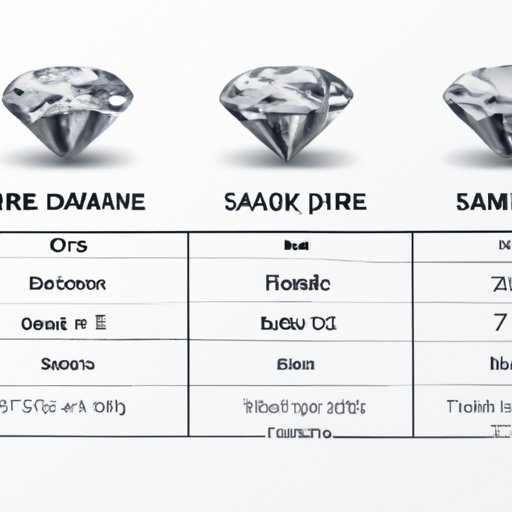Introduction
Genuine diamonds are one of the most beautiful and sought-after gemstones in the world. Not only do they have a brilliant sparkle, but they’re also incredibly durable and valuable. But not all diamonds are created equal—there are many different types of diamonds, and not all of them are genuine. In this guide, we’ll explain everything you need to know about genuine diamonds, including their formation process, benefits, and how to spot a fake from a real one.
The Science Behind Genuine Diamonds
A genuine diamond is a type of gemstone made up of extremely hard crystallized carbon atoms. Under intense pressure and heat, these atoms are arranged into a unique lattice structure that gives diamonds their strength, brilliance, and sparkle. The formation process of a genuine diamond typically occurs over millions of years deep within the Earth’s crust.
There are several different types of genuine diamonds, each with its own unique characteristics. Colorless diamonds are the most popular, followed by fancy colored diamonds, which come in a variety of hues. Other types include black diamonds, brown diamonds, and pink diamonds.
Genuine diamonds are highly prized for their beauty and durability. They’re resistant to scratches and chips, making them ideal for rings and other pieces of jewelry. They’re also incredibly valuable, making them an excellent investment.
A Guide to Buying Genuine Diamonds
When it comes time to buy a genuine diamond, there are a few key things to consider. First, you’ll want to find a reputable vendor who specializes in selling genuine diamonds. Do your research and read customer reviews to make sure the vendor is trustworthy. It’s also important to set a budget and compare prices from multiple vendors.
When buying a genuine diamond, you should always ask to see the certification paperwork. This will help you verify that the stone is authentic. You should also ask questions about the diamond’s origin and production history to ensure it was ethically sourced.

How to Spot a Fake Diamond vs. a Genuine Diamond
It’s important to be able to distinguish between a fake diamond and a genuine one. Fortunately, there are several ways to tell the difference. The first step is to do a physical inspection. Look closely at the diamond and check for imperfections or irregularities. If it looks too perfect, it may be a fake.
Another way to tell if a diamond is genuine is by looking at its color. Genuine diamonds are usually colorless, though some have a slight yellow hue. Fake diamonds, on the other hand, often have an unnatural blue or green tint. Additionally, look at the cut and clarity of the diamond. Genuine diamonds have precise cuts and are generally clear, while fake diamonds tend to be misshapen and hazy.
Finally, check the weight of the diamond. Genuine diamonds are among the heaviest gemstones, so if the stone feels light, it may be a fake.
Understanding the Four C’s of Genuine Diamonds
When buying a genuine diamond, it’s important to understand the four “C’s”: carat, cut, color, and clarity. Carat refers to the weight of the diamond, while cut refers to its shape and proportions. Color and clarity refer to the diamond’s hue and lack of imperfections, respectively.
These four criteria determine the quality and value of a genuine diamond. When assessing a diamond, it’s important to consider all four elements and how they affect the overall appearance of the stone.

History and Significance of Genuine Diamonds
Genuine diamonds have been treasured since ancient times. They were used in jewelry and other decorative objects as symbols of wealth and power. In modern times, diamonds are still seen as symbols of love, commitment, and status.
Diamonds are also used in industrial applications due to their extreme hardness. They’re used to cut and drill a variety of materials, from glass to metal.
In some cultures, diamonds are believed to possess magical powers and healing properties. For example, some believe that wearing a genuine diamond can bring good luck and protect against evil spirits.

Innovations in Genuine Diamond Jewelry
In recent years, there have been a number of innovations in genuine diamond jewelry. New settings, such as the halo setting, have become popular for engagement rings. Unique designs and shapes, such as hearts and stars, have also gained popularity. And certain trends, like rose gold and vintage-inspired styles, have become staples in the industry.
Ethically Sourced Genuine Diamonds
When buying a genuine diamond, it’s important to make sure it was ethically sourced. Conflict-free diamonds are those that have been certified by the Kimberley Process, which is an international certification system that ensures diamonds are not mined in conflict zones. Fair trade diamonds are those that are mined and traded in accordance with fair labor practices. And responsible mining practices involve companies following environmental regulations and preserving the land where diamonds are mined.
Conclusion
Genuine diamonds are beautiful and valuable gems that can last a lifetime. They’re formed deep within the Earth’s crust over millions of years and come in a variety of colors and shapes. When buying a genuine diamond, it’s important to find a reputable vendor, set a budget, compare prices, and check certifications. Additionally, there are several ways to tell if a diamond is genuine or fake, including inspecting the stone, looking at the color, cut, and clarity, and checking the weight. Finally, it’s important to make sure the diamond is ethically sourced.
By understanding what makes a genuine diamond and doing your research, you can feel confident in your purchase. With the right knowledge and preparation, you can find the perfect genuine diamond to suit your needs.


